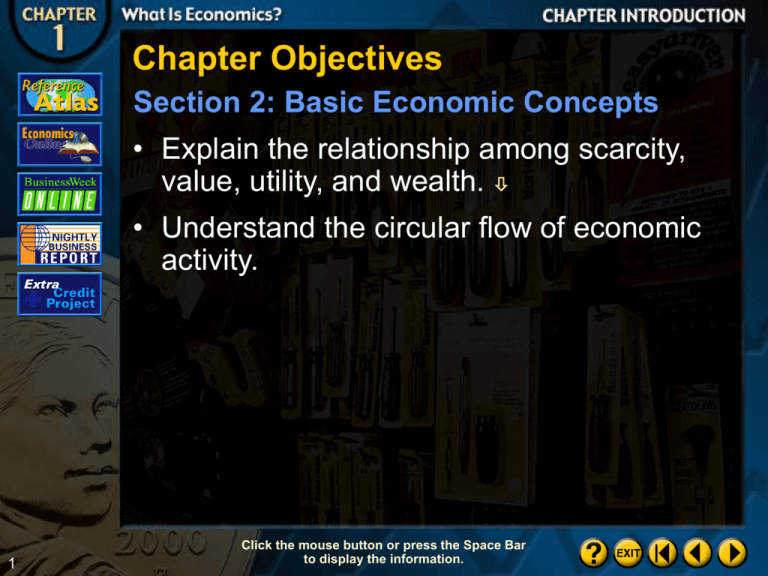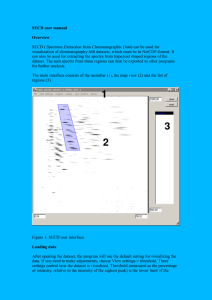Circular Flow
advertisement

Chapter Objectives Section 2: Basic Economic Concepts • Explain the relationship among scarcity, value, utility, and wealth. • Understand the circular flow of economic activity. 1 Click the mouse button or press the Space Bar to display the information. Introduction • Economics, like any other social science, has its own vocabulary. • To understand economics, a review of some key terms is necessary. • Fortunately, most economic terms are widely used, and many will already be familiar to you. 2 Click the mouse button or press the Space Bar to display the information. Goods, Services, and Consumers • Economics is concerned with economic products–goods and services that are useful, relatively scarce, and transferable to others. • Because of these characteristics, economic products command a price. 3 Click the mouse button or press the Space Bar to display the information. Goods • The first type of economic product is a good–an item that is economically useful or satisfies an economic want. – A consumer good is intended for final use by individuals. – When manufactured goods are used to produce other goods and services, they are called capital goods. – Any good that lasts three years or more when used on a regular basis is called a durable good. – A nondurable good is an item that lasts for less than three years when used on a regular basis. 4 Click the mouse button or press the Space Bar to display the information. Services • The other type of economic product is a service, or work that is performed for someone. • The difference between a good and a service is that a service is intangible, or something that cannot be touched. 5 Click the mouse button or press the Space Bar to display the information. Consumers • The consumer is a person who uses goods and services to satisfy wants and needs. • As consumers, people indulge in consumption, the process of using up goods and services in order to satisfy wants and needs. 6 Click the mouse button or press the Space Bar to display the information. Value, Utility, and Wealth • In economics, value refers to a worth that can be expressed in dollars and cents. • Why, however, does something have value, and why are some things worth more than others? 7 Click the mouse button or press the Space Bar to display the information. Paradox of Value • At first, early economists were puzzled by a contradiction between necessities and value called the paradox of value. • The paradox of value is the situation where some necessities, such as water, have little monetary value, whereas some nonnecessities, such as diamonds, have a much higher value. • Economists knew that scarcity is required for value. • The problem was that scarcity by itself is not enough to create value. 8 Click the mouse button or press the Space Bar to display the information. Utility • It turned out that for something to have value, it must also have utility, or the capacity to be useful and provide satisfaction. • The utility of a good or service may vary from one person to the next. • A good or service does not have to have utility for everyone, only utility for some. • For something to have value it must be scarce and have utility. • This is the solution to the paradox of value. 9 Click the mouse button or press the Space Bar to display the information. Wealth • Wealth, in an economic sense, is the accumulation of those products that are tangible, scarce, useful, and transferable from one person to another. • While goods are counted as wealth, services are not because they are intangible. • However, this does not mean that services are not useful as they may be the source of wealth. 10 Click the mouse button or press the Space Bar to display the information. The Circular Flow of Economic Activity • The wealth that an economy generates is made possible by the circular flow of economic activity. • The key feature of this circular flow is the market, a location or other mechanism that allows buyers and sellers to exchange a certain economic product. • Markets may be local, regional, national, or global. • More recently, markets have evolved in cyberspace. 11 Click the mouse button or press the Space Bar to display the information. Factor Markets • How does this circular flow operate? • Individuals earn their incomes in factor markets or resource market, the markets where productive resources are bought and Figure 1.3 sold. • While the concept of a factor market is a simplified version of the real world, nevertheless, it is realistic. 12 Click the mouse button or press the Space Bar to display the information. Product Markets • After individuals receive their income from the resources they sell, they spend it in product markets. • These are markets where producers sell Figure 1.3 their goods and services to consumers. 13 Click the mouse button or press the Space Bar to display the information. Product Markets (cont.) • Businesses then use this money to produce more goods and services. • Markets serve as the main links between individuals and businesses. • Money provides payments for goods, services, and the factors of production. 14 Figure 1.3 Click the mouse button or press the Space Bar to display the information. Productivity and Economic Growth • Economic growth occurs when a nation’s total output of goods and services increases over time. • This means that the circular flow becomes larger, with more factors of production, goods, and services flowing in one direction, and more payments flowing in the opposite direction. • A number of factors are responsible for economic growth, but productivity is the most important. 15 Click the mouse button or press the Space Bar to display the information. Productivity • Everyone benefits when scarce resources are used efficiently. • This is described by the term productivity, which is a measure of the amount of output produced by a given amount of inputs in a specific period of time. • Productivity goes up whenever more output can be produced with the same amount of inputs in the same amount of time. • Productivity is often discussed in terms of labor, but it applies to all factors of production. 16 Click the mouse button or press the Space Bar to display the information. Figure 1.4 17 Click the mouse button or press the Space Bar to display the information.





